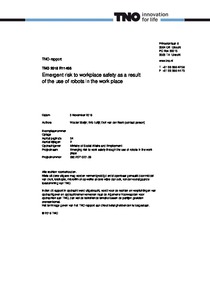Emergent risk to workplace safety as a result of the use of robots in the work place
"In the past fifty years, robots have become much faster and more accurate, but in many cases they do no more than operate in one particular location or on rails, automatically carrying out perhaps only a single task within a fixed hazardous zone or inside a safety cage. Despite the aforementio...
| Main Authors: | , , |
|---|---|
| Institution: | ETUI-European Trade Union Institute |
| Format: | TEXT |
| Language: | English |
| Published: |
Utrecht
2016
TNO |
| Subjects: | |
| Online Access: | https://www.labourline.org/KENTIKA-19396449124911146219-emergent-risk-to-workplace-saf.htm |
| _version_ | 1771659897461538818 |
|---|---|
| author | Steijn, Wouter Luiijf, Eric van der Beek, Dolf |
| author_facet | Steijn, Wouter Luiijf, Eric van der Beek, Dolf |
| collection | Library items |
| description | "In the past fifty years, robots have become much faster and more accurate, but in many cases they do no more than operate in one particular location or on rails, automatically carrying out perhaps only a single task within a fixed hazardous zone or inside a safety cage. Despite the aforementioned limitations, today’s industrial robots have introduced new risk to the work place even though their areas of operation are clearly defined in safety zones or cages. Given that industrial robots are increasingly being used in agriculture, horticulture, the manufacturing sector and distribution warehouses, it is likely that accidents will occur more frequently in the future. Moreover, the programming of industrial robots will become increasingly complex as their tasks continue to increase either in scope or complexity. Progress is also being made with regard to robots that can move and ‘see’ and respond to their surroundings4. It is therefore quite conceivable that people will be working alongside robots in the near future, in settings that are no longer limited to a fixed location or inside a cage. People and robots will also be moving around in the same areas or rooms. This means that the risk of injury as a direct result of collisions between people and robots will increase, but indirect work-safety risk will be heightened too because of the equipment that robots may be using, and which could pose dangers to employees in the vicinity. It is important, as far as this trend is concerned, to look ahead and to define the machine safety of the future, so that robots can proactively be made intrinsically safe as early as the design and development stages." |
| format | TEXT |
| geographic | Netherlands |
| id | 19396449124911146219_3dd97cdf86164e7da133d7f787cec4b5 |
| institution | ETUI-European Trade Union Institute |
| is_hierarchy_id | 19396449124911146219_3dd97cdf86164e7da133d7f787cec4b5 |
| is_hierarchy_title | Emergent risk to workplace safety as a result of the use of robots in the work place |
| language | English |
| physical | 54 p. Digital |
| publishDate | 2016 |
| publisher | Utrecht TNO |
| spellingShingle | Steijn, Wouter Luiijf, Eric van der Beek, Dolf robots human-system interface occupational safety occupational risks safety by design legislation Emergent risk to workplace safety as a result of the use of robots in the work place |
| thumbnail | https://www.labourline.org/Image_prev.jpg?Archive=131534695971 |
| title | Emergent risk to workplace safety as a result of the use of robots in the work place |
| topic | robots human-system interface occupational safety occupational risks safety by design legislation |
| url | https://www.labourline.org/KENTIKA-19396449124911146219-emergent-risk-to-workplace-saf.htm |

